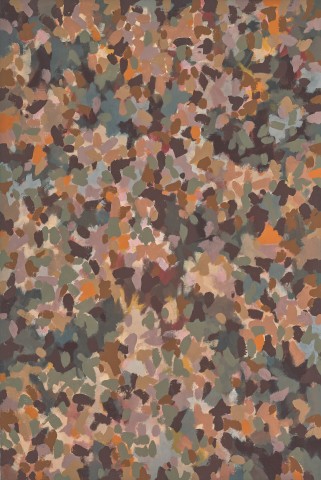FALLEN TREE, 1976
DAVID ASPDEN
synthetic polymer paint on canvas
235.0 x 156.5 cm
Rudy Komon Gallery, Sydney (label attached verso)
Tolarno Galleries, Melbourne
The National Australia Bank Art Collection, acquired from the above in 1979 (label attached verso)
David Aspden: Paintings, prints and collages, Rudy Komon Gallery, Sydney, 23 June – 18 July 1979
The Seventies: Australian Paintings and Tapestries from the Collection of National Australia Bank, National Gallery of Victoria, Melbourne, 15 October – 28 November 1982
The Seventies: Australian Paintings and Tapestries from the Collection of National Australia Bank, Geelong Art Gallery, Victoria, 30 April - 29 May 1988
Nicholson, M., ‘Price of Freedom’, The Bulletin, Sydney, vol. 98, no. 5004, 24 April 1976, p. 53
The First Gallery in Paddington. The artists and their work tell the story of the Rudy Komon Art Gallery, Edwards & Shaw, Sydney, 1981, p. 16 (illus.)
Lindsay, R., The Seventies: Australian Paintings and Tapestries from the Collection of National Australia Bank, The National Bank of Australasia, Melbourne, 1982, pl. 3, p. 16 (illus.)
Taylor, P., Anything Goes: Art in Australia 1970 – 1980, Art & Text, Melbourne, 1984, p. 41 (illus.)
David Aspden is not the only Australian artist to be lauded as an exceptional Colourfield painter whose work later softened to become lyrical, at times poetic. According to a review of an exhibition at the time of his death, ‘Australia has never had a better abstract painter.’ The reviewer named names - those he thought Aspden surpassed.1
Aspden’s colourfield work was sufficiently different in approach and he avoided being typecast as a remote New York acolyte: he was interested in ‘space as colour, not just colour’ and when he represented Australia at the São Paulo Biennial in 1971 his surfaces had become large, coloured interlocking shapes with irregular serrated edges.2 Aspden has acknowledged that many traits were lifted directly from years as a sign writer and painter in Wollongong.
A shift soon followed São Paulo where shapes or an edge, anywhere had gone completely. Surfaces dissolved into all-over painterliness where the process itself took over – pouring, dripping, splattering and the application of paint suggests the absence or directness of the artist’s hand. Despite Aspden’s skilled draughtsmanship he always sought to free painting from drawing as much as possible.
A decade of apparent deviations might seem somewhat unusual, but it is not unique. We might see Ralph Balson (1890 – 1964) in the same light - from his Constructive geometric paintings in the forties and early fifties to his daubed Painting and writhing Matter paintings from the late fifties and early sixties, respectively.3
Fallen Tree marks a phase that was never lost or abandoned. The deliberate painting technique and the reference to nature is clear on first glance and is given in the title. The camouflage effect suggests a means to avoid literalism, to allow the subject that inspired the painting to be concentrated and emphasised. It is an approach which occurs in many guises and palette ranges over the next three decades. In his final exhibition Aspden offered a succinct summary:
‘… in this exhibition a great deal of reference to landscape and the environment. I am challenged by the colours that can be found in the air, wind and weather, as well as more easily recognizable colours in the tangible world of nature.’4
Aspden was a serious Jazz devotee. In his work from the seventies, we sense a spontaneity and improvisation and here in Fallen Tree a visual orchestration of muted tones, reflected upon, then developed and refined in the making of the painting itself.
1. Smee, S., ‘National Art Critic’, The Australian: Review, 12 July 2005
2. Australia XI Bienal de São Paulo, 1971. Aspden represented Australia with Gunter Christmann; the former was awarded a Gold Medal.
3. Constructive painting, 1947, oil on composition board, collection of the Queensland Art Gallery / Gallery of Modern Art, Brisbane, purchased 1984; Painting No 9, 1959, synthetic polymer paint on hardboard, collection of the Art Gallery of New South Wales, Sydney, purchased 1960; Matter Painting, 1961, synthetic polymer paint and concrete on hardboard, collection of the Art Gallery of New South Wales, Sydney, gift of Chris and Susannah Turle 2013
4. David Aspden, Paintings 1973 – 2005, Wagner Gallery, Sydney, 9 July – 4 August 2005
DOUG HALL AM
